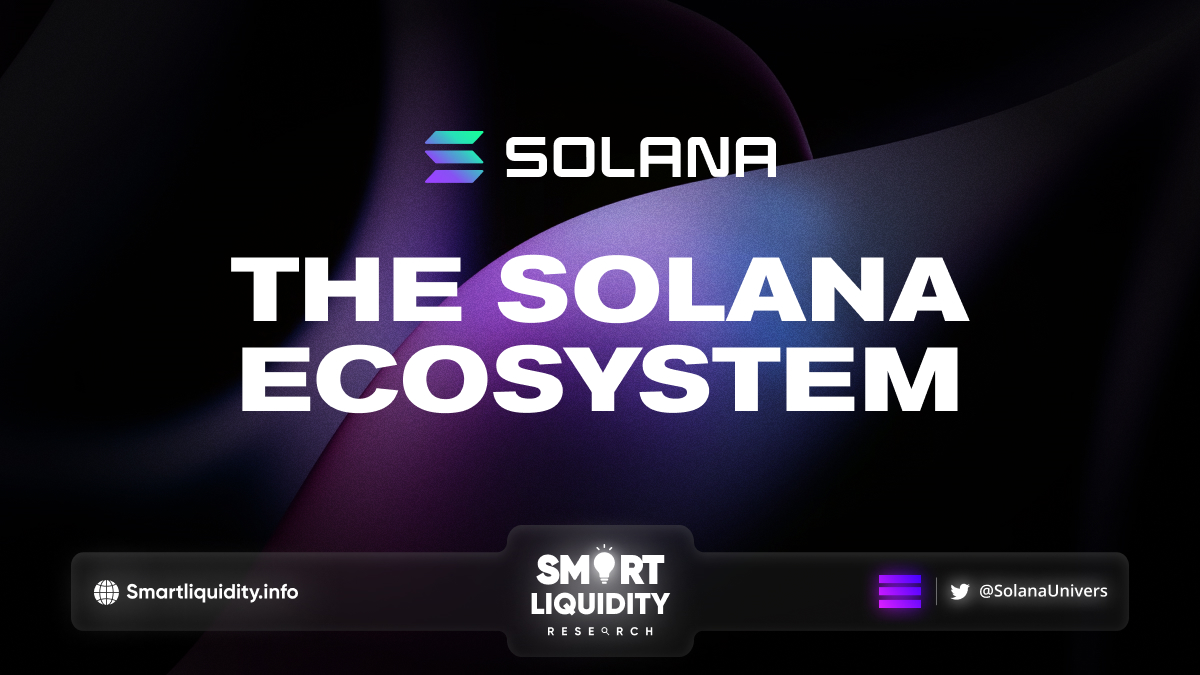The Solana Ecosystem


Solana is a high-performance blockchain platform designed to support decentralized applications (dApps) and crypto assets. It was launched in 2017 by the Solana Foundation and aims to solve some of the scalability issues that have been plaguing other blockchain platforms.
The Solana ecosystem is designed to offer a fast, secure, and scalable platform for building decentralized applications and exchanging digital assets. Additionally, it has gained significant attention and popularity in the cryptocurrency world due to its remarkable performance and potential for innovation.
The Solana Ecosystem Comprises Various Components, including:
- The Solana blockchain: Furthermore, this core component of the ecosystem is designed to provide exceptionally rapid transaction processing times. Solana’s unique architecture allows it to handle up to 65,000 transactions per second (TPS), which is significantly higher than many other blockchains.
- Solana Smart Contracts: These are the programs that run on the Solana blockchain, and they allow developers to build decentralized applications (dApps) on top of the platform. Solana supports the Solidity programming language, which is identical to the language used for creating smart contracts on the Ethereum blockchain.
- The Solana Wallet: This is a software application that allows users to store, send, and receive Solana tokens, as well as other cryptocurrencies and digital assets.
- Solana Explorer: This is a web-based tool that allows users to view transactions, blocks, and other data on the Solana blockchain.
- Solana Labs: This is the organization behind the Solana project, and it provides support, education, and resources for developers who are building on the platform.
Solana’s Distinctive Features Stand Out from Other Blockchains
- High transaction processing speed: Solana’s design aims to provide exceptionally rapid transaction processing times, capable of managing up to 65,000 transactions per second (TPS). This is significantly higher than most other blockchains, which typically have TPS in the range of a few dozen to a few thousand.
- Proof-of-History (PoH): Solana uses a unique consensus algorithm called Proof-of-History (PoH) that enables it to achieve its high TPS rate. PoH is a cryptographic clock that provides a historical record of all the transactions that have taken place on the blockchain. By using this historical record, Solana can process transactions more efficiently and quickly.
- Low transaction fees: Despite its high TPS rate, Solana has very low transaction fees compared to other blockchains. This is partly due to its efficient transaction processing, but it is also because Solana uses a novel fee-bidding system that allows users to set their own transaction fees.
- Support for Solidity: Solana supports the Solidity programming language, which is prevalent in developing smart contracts on the Ethereum blockchain, making it one of the rare blockchain platforms that do so. This makes it easier for developers who are familiar with Solidity to build decentralized applications (dApps) on Solana.
- Ecosystem and community support: Solana has a growing ecosystem of developers, investors, and supporters who are actively building on the platform and promoting its adoption. This has helped to create a vibrant community around Solana, which is important for the long-term success and sustainability of the platform.
The SOL Token: Understanding Solana’s Native Cryptocurrency
The SOL token is the native cryptocurrency of the Solana blockchain. Within the Solana ecosystem, the SOL token functions as both a store of value and a medium of exchange. The SOL token is a critical element of the Solana blockchain, utilized to cover various network fees such as transaction fees, smart contract execution fees, and others.
The SOL token has a fixed maximum supply of 489,003,274 tokens and serves as an incentive for network validators and users participating in the network. The Solana network rewards validators, who verify and validate transactions on the blockchain, with SOL tokens.
Price Growth and Adoption of SOL
Users can acquire SOL tokens by purchasing them on cryptocurrency exchanges, receiving them as rewards for staking their tokens on the Solana network, or by earning them as rewards for participating in decentralized applications built on the Solana blockchain.
The SOL token has seen significant price growth and adoption in recent years, reflecting the growing interest and demand for the Solana blockchain and its ecosystem. As with all cryptocurrencies, the price of SOL can be volatile, and investors should exercise caution and conduct their own research before investing in the token.
Exploring the Use Cases of Solana Token
- Decentralized applications (dApps): Solana’s high transaction speed and low fees make it ideal for building fast and scalable dApps.
- Gaming: Developers can use the Solana network to build blockchain-based games that require high-speed transaction processing and low latency.
- Decentralized finance (DeFi): Solana can serve as a platform for developing DeFi applications like lending, borrowing, and trading platforms.
- Non-fungible tokens (NFTs): Solana enables the creation and trading of NFTs, which are distinct digital assets such as art, music, and collectibles.
- Supply chain management: Solana’s blockchain technology enables tracking and verifying the authenticity of products in the supply chain.
Overall, Solana Token could potentially serve various industries and applications that require blockchain technology with fast, secure, and scalable features.
Conclusion
Solana’s ecosystem provides an innovative and promising approach to blockchain technology, addressing issues of speed, scalability, and security. With its unique features, such as support for the Solidity programming language and the potential to handle a high volume of transactions, Solana has gained considerable attention and popularity in the cryptocurrency world. Its ability to enable the creation of decentralized applications, the tracking of supply chains, and the creation and trading of NFTs makes it a versatile platform with vast potential for numerous industries and applications. As the technology continues to develop and evolve, Solana’s ecosystem is one to watch for further advancements and progress.
REQUEST AN ARTICLE




